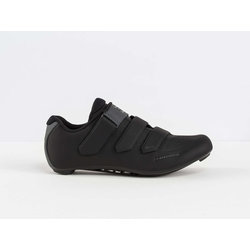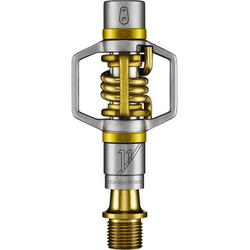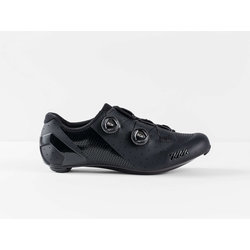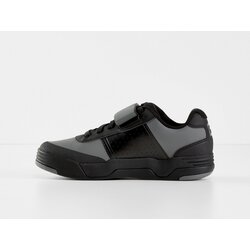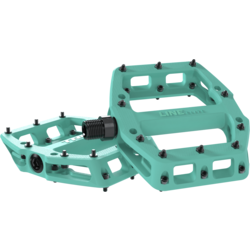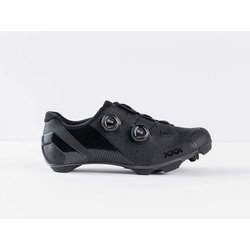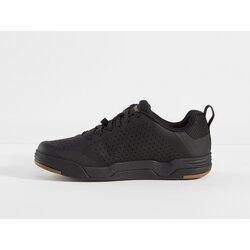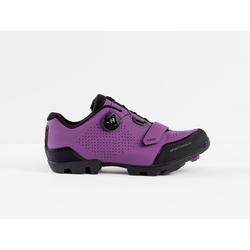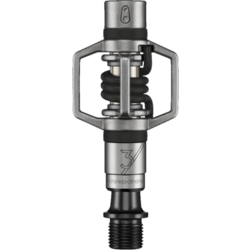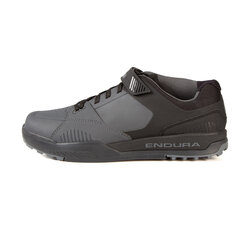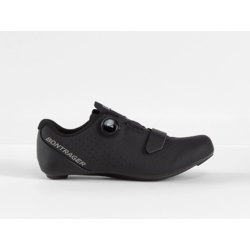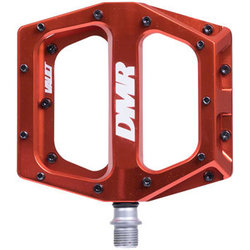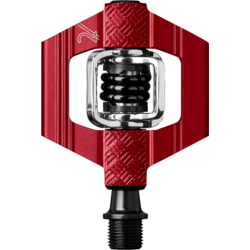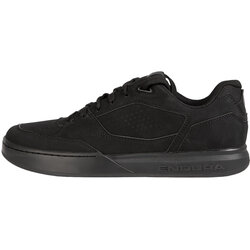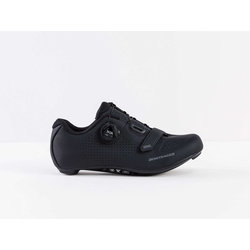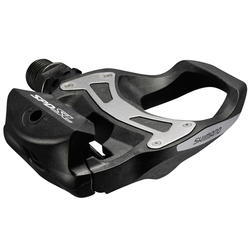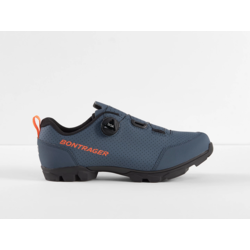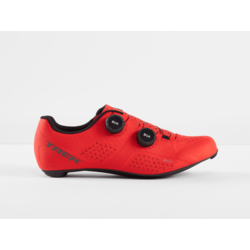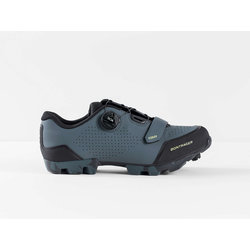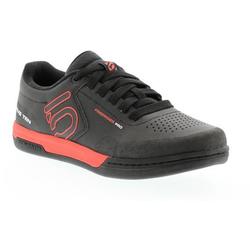Clipless Pedals And Cycling Shoes
After selecting a bicycle that meets your specific needs, getting cycling shoes and pedals will make a huge difference in your riding. We recommend clipless pedal and shoe systems for frequent riders because they more efficiently transfer your pedaling power to the ground and the shoes have stiff soles to support and protect your feet for more comfort.
Borrowed from skiing technology, these trick pedals also provide a better foot-to-pedal connection and more safety by offering almost instant foot entry and release. We like clipless pedals for road and mountain biking and for everything from recreational riding to commuting and racing. They're also great for Spinning classes.
If you're new to bicycling, getting new pedals and shoes (both are required for going clipless) might seem a bit much. The way to decide whether it's worth the expense is considering your cycling. If you ride regularly on loops of 10 miles or more and expect to keep riding for years to come, we think you'll love the way a clipless system enhances the cycling experience by boosting your pedal power, comfort and safety.
What are clipless pedals?
Clipless pedals are actually a system comprised of special pedals and cleats, devices included with the pedals that attach to the soles of clipless cycling shoes. This means that you need to select pedals and shoes in order to upgrade to a clipless system.
Once you have the cleats bolted to your shoes and the clipless pedals on your bicycle (we're happy to help), you simply put on your new shoes and step on the pedals to click your feet securely in place (most systems make a "click" when you're locked in). When engaged, your feet are connected to the pedals for optimum efficiency. And your feet won't come off the pedals unless you want them to. To get out, you swing your heels to the outside as if you're getting ready to put your feet down, and the pedals release.
 |
 |
 |
 |
 |
 |
 |
 |
 |
 |
Because your feet are locked into the pedals when riding, you have more power throughout the pedal stroke and while accelerating and climbing. Clipless pedals also give you more control by letting you use your feet for maneuvers such as hopping pavement cracks, railroad tracks and more exciting obstacles if you're riding off road.
Plus, because you can get in and out so quickly, you're more apt to get your feet down and land safely should you need to dismount quickly. With all of these advantages, is it any wonder that almost all serious pedalers use clipless pedals today and some new bikes even come equipped with them?
What are the different types of shoes?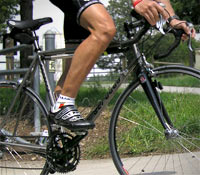 Road Riding: Road shoes have the stiffest soles, made of nylon, composite materials or carbon for maximum pedaling efficiency and minimum weight. These shoes usually sport lightweight ventilated uppers made from leather or synthetic leathers like Lorica, with mesh for breathability. Velcro-strap or ratcheting-buckle closures are popular so that adjustments can be made "on the fly," tighter for climbing or sprinting, looser if your feet swell or feel uncomfortable.
Road Riding: Road shoes have the stiffest soles, made of nylon, composite materials or carbon for maximum pedaling efficiency and minimum weight. These shoes usually sport lightweight ventilated uppers made from leather or synthetic leathers like Lorica, with mesh for breathability. Velcro-strap or ratcheting-buckle closures are popular so that adjustments can be made "on the fly," tighter for climbing or sprinting, looser if your feet swell or feel uncomfortable.
Racers do not need to put their feet down very often, so having recessed cleats is not important. However, standard road cleats that protrude from the soles can make those occasions when you do need to walk a bit awkward. Fortunately, to provide traction for easier and safer walking and to help protect the cleats, rubber cleat covers are available for many different clipless systems. We recommend picking up a pair and carrying them on rides so you can walk easily and save your cleats from wear and tear.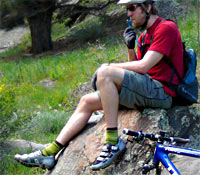 Off-Road: Off-road shoes are also quite stiff and inflexible but not as much as road models. Like the road riders, off roaders want good power transfer through the shoes to the pedals. However, off-road shoes all have recessed cleats and aggressive tread patterns for those occasions when it's necessary to get off and hoof it. Some shoes even accept optional screw-in studs near the toes for grip on muddy trails. Uppers are usually a little more robust than on road shoes, to cope with brushing through the undergrowth. If laces are used, these are usually hidden by a protective tongue. Soggy laces are no fun to untie when you're tired after a tough ride!
Off-Road: Off-road shoes are also quite stiff and inflexible but not as much as road models. Like the road riders, off roaders want good power transfer through the shoes to the pedals. However, off-road shoes all have recessed cleats and aggressive tread patterns for those occasions when it's necessary to get off and hoof it. Some shoes even accept optional screw-in studs near the toes for grip on muddy trails. Uppers are usually a little more robust than on road shoes, to cope with brushing through the undergrowth. If laces are used, these are usually hidden by a protective tongue. Soggy laces are no fun to untie when you're tired after a tough ride!
Casual Riding: Shoes for casual riding are manufactured with comfort in mind, and therefore tend to be a little more flexible than their super-stiff racing brothers, as the pressure exerted on them will not be so great and they will be used for more walking. Many tourists choose casual shoes with clipless pedals because of their versatility and they may wear them for long days of riding (or even throughout a prolonged tour) and so appreciate the little extra forgiveness in the soles. Styles vary from boot-like designs to low cut, almost racing-style shoes with some good compromise models in terms of colors, weight and design in the middle ground.
| How you ride... | The shoe for you... |
| You're a casual cyclist who doesn't feel comfortable looking like a gonzo bikie. | Consider casual cycling shoes, which look more like sneakers. There are even cleated models that work with clipless pedals. |
| You love rolling up the miles and you enjoy stopping to admire the view almost as much. | Look at shoes made for touring. They're flexible for comfort with rubber soles and recessed cleats for walking. Off-road styles work, too. |
| You love off-road rides and races. | You want lugged soles, recessed cleats, a snug, comfy fit, light weight, decent sole stiffness (not too stiff) and a secure fastening system. |
| You've been on off-roader and now you plan to get a road bike. | You may want to continue using your off-road shoes. Just get the same pedals for your road bike that you have on your off-roader. |
| You're a serious triathlete. | Check out triathlon shoes, which are designed for high efficiency with features to get in and out quick. |
| You ride centuries and group rides that are more social than competitive. | You'll do fine with a mid-line road shoe because it'll be more flexible and comfortable than the full-on road race model (see below). |
| You enjoy hammering on the road sprinting against your buddies for every city-limit sign. | Get light, high-end road shoes with super-stiff soles for exceptional energy transfer and an extra-secure closure system. |
Fit
Cycling shoes fit more snugly so your feet won't slip around inside when you're pedaling. This is also why you should always wear cycling socks with your shoes. They're thin so they won't stretch the shoes, ruining the fit.
They are also made of synthetic and/or wool blends to breathe and keep your feet dry and comfortable (cotton holds onto moisture). A good pair of cycling socks will last a long time too.
Note that after rainy/wet rides that soak your shoes, you should stuff them with newspaper so they dry nicely and the fit is maintained.
Clips and straps versus clipless
If you're cycling short distances and pedaling casually, basic rubber pedals work fine. As you bike more seriously, say to achieve fitness, the speed you pedal and the distance you cover increases and there's a risk of your feet slipping off the pedals.
At the least, this is an annoyance. At the worst, it can cause a crash and injury. Also, even if you never slip off the pedals, rubber pedals allow your feet to change positions while you're pedaling, which wastes energy. Ideally, you'll always pedal with the balls of your feet over the centers of the pedals. Because it's difficult to keep your feet in this position when you're pedaling quickly, toe clips and straps were invented (shortly after bicycles were invented, actually).
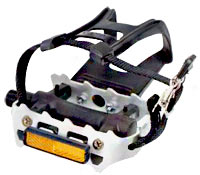 Toe clips and straps bolt to most regular pedals (non-clipless) that have holes in them to accept the bolts that hold the clips in place. The clips and straps form cages to hold your feet in the correct place on the pedals and keep your feet from slipping off. This is a perfectly viable solution and less expensive than clipless pedals and the special shoes needed to complete the clipless system.
Toe clips and straps bolt to most regular pedals (non-clipless) that have holes in them to accept the bolts that hold the clips in place. The clips and straps form cages to hold your feet in the correct place on the pedals and keep your feet from slipping off. This is a perfectly viable solution and less expensive than clipless pedals and the special shoes needed to complete the clipless system.
There are drawbacks, however. One is that the clips and straps may cut off the circulation to your feet when they're fastened tightly enough to allow efficient pedaling and control. It's also a fairly tricky two-step process to get out of the clips and straps when they're tightened because you must reach down to loosen the strap before you can pull your foot out. Also, when you're riding off road on the pedal bottoms, the clips and straps hang down where they can snag on roots or sticks, stopping the bike abruptly and possibly causing a crash.
These are just some of the reasons that clipless pedals are now de rigueur for serious cyclists. The only real disadvantage is the initial expense and that they take a little practice to learn how to use (true with toe clips and straps, too).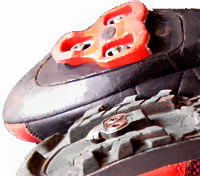 Two styles of clipless pedals/shoes: walkable and road
Two styles of clipless pedals/shoes: walkable and road
Just like there are two places to ride, on and off road, there are two types of clipless systems. The most popular are walkable clipless systems, on which the cleats are recessed into the shoe soles (see the bottom shoe in the photo on the right). This means the cleats don't contact the ground when you walk so this clipless system is ideal for walking and even hiking. Yet, it's still incredibly efficient for maximum pedal power. Walkable clipless pedals and shoes are ideal for off-road riding, commuting, touring and century riding, too.
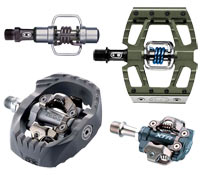 Many of them utilize a double-sided pedal (photo,left), which means you can click into the pedal on either side so you don't have to look down to get your feet in. Also some of these pedals offer a platform around the piece that engages the cleat.
Many of them utilize a double-sided pedal (photo,left), which means you can click into the pedal on either side so you don't have to look down to get your feet in. Also some of these pedals offer a platform around the piece that engages the cleat.
This is beneficial when you either want to be unclipped or you can’t clip in fast enough — you’ll still have a good base of support. This is also convenient if you’re wearing regular street shoes because you'll have a good pedaling surface even though you're not using your special cleated cycling shoes.
The other system is road (the red cleat in the photo above, right) and as the name implies it's designed for use on road bikes where maximum efficiency, aerodynamics and minimum weight are all important. Road shoes are lighter and stiffer than walkable models because the soles aren't lugged.
The other difference in road clipless systems is that the cleats protrude from the soles of the shoes because the soles are so thin and light. This makes it difficult to walk in the shoes (though there are rubber cleat covers available to protect the cleat and improve traction).
Also, road systems usually are single-sided so you must find the correct side of the pedal to click in when you start out. Most road pedals hang a certain way to make this relatively easy.
Float and tension adjustment
The majority of clipless systems today feature float. This is a few degrees of built-in lateral play allowing your feet to move slightly and find the optimum pedaling position. Float ensures that you won't injure your knees by riding with your feet misaligned with your knees, which was a common problem before pedals with float were invented.
Keep in mind that even though most clipless pedals offer float, it's still important to align the cleats carefully. They must be positioned to hold the balls of your feet over the pedals and to match your natural foot inclination. Our bike fitters are experts at this.
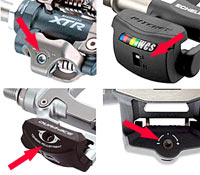 Another adjustment many clipless pedals offer is fine-tuning the ease of entry and exit by adjusting the tension that holds the shoes in place on the pedal. Competitive riders often set it very firm because they don't want their feet popping out in all-out sprinting efforts or bumpy, high-speed sections of the trail. Meanwhile, beginners may like a loose setting so that they can get out with very little effort should they need to get their feet down in a hurry.
Another adjustment many clipless pedals offer is fine-tuning the ease of entry and exit by adjusting the tension that holds the shoes in place on the pedal. Competitive riders often set it very firm because they don't want their feet popping out in all-out sprinting efforts or bumpy, high-speed sections of the trail. Meanwhile, beginners may like a loose setting so that they can get out with very little effort should they need to get their feet down in a hurry.
This adjustment can generally be made two different ways depending on your pedals. The majority of pedals offer an adjustment on the pedal (photo, right), or you can swap to different cleats with a greater or lesser degree of exit angle on other models.
When buying clipless pedals be sure to tell us how you'd like the pedals set so we can get them just right. We can also show you how to fine-tune the adjustment. A trick some riders like is to set their double-sided clipless pedals so that one side has a higher tension setting than the other. That way, you can choose which side to click into depending on the conditions.
Getting used to riding clipless
The most important thing is practicing before hitting the road or trail. This is especially important if you started with toe clips and straps, which require a different foot motion to get your feet out. Clipless pedals release by swinging your heels outward (photo).
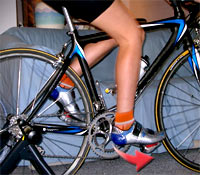 Teach your feet this motion while standing over the bike. You're just going to practice getting your feet in and out, not sit on the seat or ride anywhere. If you're worried about falling over, practice on a lawn or soft surface. Even better, if you have an indoor trainer, mount your bike on it and practice in place.
Teach your feet this motion while standing over the bike. You're just going to practice getting your feet in and out, not sit on the seat or ride anywhere. If you're worried about falling over, practice on a lawn or soft surface. Even better, if you have an indoor trainer, mount your bike on it and practice in place.
Click your right foot into the right pedal and remove it 50 or more times, and repeat with your left. It should begin to feel natural and easy. Keep clicking and releasing until you've really got it down. You're training your muscle memory so you can do this without thinking about it — even better: without looking down!
When you're comfortable getting in and out of the pedals, do a short loop around the neighborhood and practice entering and exiting the pedals for real. The trickiest thing the first couple of times is remembering to swivel your heels to get out instead of pulling back (the toe-clip motion). As long as you keep the correct motion in mind you'll get your feet out just fine.
If you're worried about it, plan your neighborhood test loop to end next to a telephone pole you can hang onto for insurance. Remember too that you don't have to stop if you're not ready to get your feet out. Just keep riding and find something to hold onto like a parked car or parking meter, and then click out of the pedals.
If you're still having trouble getting in and out of the pedals, practice some more while standing next to the bike. There might also be something making it harder to get out of the pedals, such as a too-tight adjustment, a misaligned or loose cleat. If that's the case, be sure to bring your bike and shoes in so we can have a look, solve any problems and get you going.
Buying Tips
Save your bucks. You don't have to buy a company's most-expensive model to get great clipless pedals. What that extra cash buys you is lighter weight, a little more durability and sometimes added adjustability. If you don't need these extras, save your loot and go with a budget model. You'll still get excellent pedal power.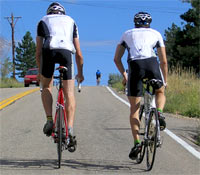
Be a copycat. If you haven't a clue what pedal system to buy and don't want to shop around, take the easy way out and simply ask ride partners what they ride and then follow suit. If they ride the local roads and trails the way you do, the chances are good their pedals will work for you, too.
Know your needs. Before shopping for pedals, figure out what you need in a pedal and shoe system. Will you walk in the shoes a lot? Do you ride trails, road, both? Are weight and high function important? The better you can define what you want, the easier it'll be for us to help you into the right system.
Buy a system. If you're just getting going, the way to go is purchasing a pedal and shoe system; in other words shoes and pedals that are made for each other. To be sure you get such a system, you must make sure the shoes you purchase are compatible with the pedals you select. If you buy pedals and shoes from the same manufacturer, the system will work nicely. However, you may want a different shoe because it fits better. Just be sure that the shoe you pick is compatible with the pedal system you use. Most quality shoes work fine with the major pedal systems but once in a while there are mismatches and you want to avoid those. We're experts on this, so don't hesitate to ask.
Find a fine fit. Cycling shoes shouldn't fit like street shoes. For road shoes, purchase a glove-like fit. The shoes should be snug with just enough room up front to wiggle your toes. The foot should be held tightly inside the shoe and should not be able to slide forward and back. And your heel should fit snug and not have a tendency to lift. For mountain-biking shoes, the fit is similar except that you may walk in these shoes a lot. So, leave a little more room in the front of the shoe. Mountain biking shoes fit like tight running shoes.
Consider extra cleats. Cleats are included with the pedals, not the shoes. If you want to set up several pairs of shoes for use with one set of pedals, purchase cleats separately. If you log mega mileage, you might even buy a spare set to have at the ready for when your cleats wear out so you don't have to waste time finding replacements.
Consider extra pedals, too! If you have several bicycles, you might want to purchase clipless pedals for the ones you ride most so that you can use your clipless shoes (and enjoy all the benefits of going clipless) regardless of which bike you choose to ride.
Proper shoes and clips or cleats working as a unit are important to achieve maximum efficiency in powering the pedals. Be sure your pedals, cleats and shoes are all compatible for maximum efficiency! If you have any questions, be sure to ask us.
When shoe shopping, don't underestimate the importance of trying them on. Some brands run wider than others. Some sole shapes may fit your feet better than others. Some brands run big and some run small. No matter how much you like the look or features of a shoe, a lousy fit can ruin rides. So, it's always best to come in and try some on. We look forward to answering your questions and helping you find the perfect fit!

